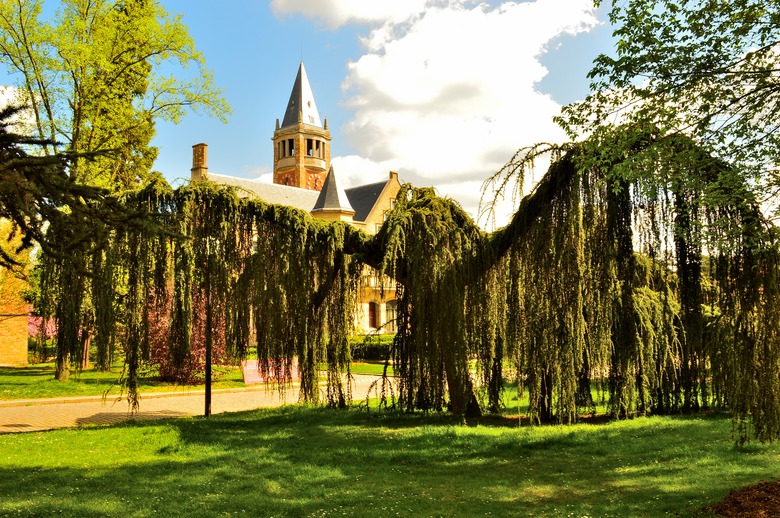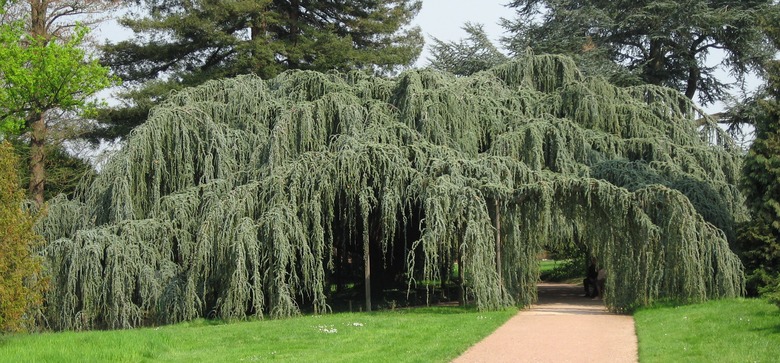How To Train A Weeping Blue Atlas Cedar
Some weeping trees display a curious biological phenomenon in which, when young, they lack the will to stand upright. Instead, they droop and grow horizontally unless staked. The weeping blue atlas cedar is one of these special cases, and this trait provides marvelous opportunities for training this tree into various shapes.
Weeping blue atlas cedar trees (Cedrus atlantica 'Glauca Pendula', USDA hardiness zones 6 to 8) are commonly pruned to cascade over walls or shaped into serpentine forms so that their trunks wind or curve like a serpent. It can also be trained as an espalier to grow in a more 2-D shape flat against a wall or supporting structure.
About the Blue Atlas Cedar
The blue atlas cedar, with its lovely silver-blue needles, has pliable branches that particularly suit it and other trees like it to be pruned into shapes. Furthermore, it is a weeping species with a growth habit that lacks geotropism, which is the natural propensity for a plant to grow upward.
Think of most plants in your garden that, if they fall on their side, the tips of their stems turn upward. Not true with the weeping form of the blue atlas cedar, according to the University of Arkansas.
When you get your hands on a weeping blue atlas cedar, take care to find a landscape location where it can be a specimen tree and where it has plenty of room to spread. It needs well-draining soil in a full-sun location.
It prefers acidic soil containing loam, but it is somewhat forgiving about soil type and can grow in clay or sandy soil with neutral pH if that is what your garden has.
It also needs support to help you form it into the shape you desire.
Basic Pruning Concepts
Start by staking the primary trunk, which is less like a trunk to start and more like a large branch. The goal is to re-establish "apical dominance," in which a central leader grows upright; otherwise, the tree will crawl along the ground and spread out horizontally.
Staking a weeping tree to develop an upright trunk takes time and attention. This tree has a fast growth rate and needs to be regularly inspected to ensure that the weeping tip of the developing "trunk" is attached to the stake or support.
It's also very important to avoid girdling the tree with the ties, which can irreparably damage it. Remove ties from the trunk when it can support itself upright, retaining ties only on the still-pliable parts of the trunk or branches.
Pruning the Blue Atlas Cedar Into Forms
Now let's look at how to prune the blue atlas cedar into three of its most prominent forms.
Creating an Espalier Form
Books have been written over centuries about training trees into espalier forms, and the primary concepts all apply to a weeping cedar. First off, you need to build the framework on which to train your tree.
Espaliers take many forms, but a weeping cedar does not lend itself to a formal, precise pattern like some fruit trees might; instead, its marvelous, drooping branches should be allowed space to cascade down from their supports without being tightly pruned.
The key point about an espaliered tree is that it is trained to grow against a support in a 2-D form, rather than its natural 3-D shape.
Here are some basic concepts:
- Decide on a form, either a somewhat free form in which you tie branches to a support as you go or a specific design.
- Create the supporting structure. This usually consists of a support with heavy wires on which you tie the branches to train them. These wires can be attached to a wall or a freestanding trellis.
- Ensure good air circulation if growing against a wall or fence, with at least 8 inches between the tree and the structure.
- Select the strongest, largest, most central branch to be the "leader." Train this leader up to the desired height, and then allow it to branch to create your form.
- Perform the heavier pruning to shape the tree by removing undesired branches while the tree is dormant, usually in late winter or early spring.
- Shape regularly during the growing season when the new growth is soft and pliable by tying the branches to the support in the desired shape.
- Use soft ties such as nylon stockings or strips of rags or raffia to avoid damaging the bark, and check them regularly to make sure they are not restricting growth.
- After the final form has been achieved, continue to prune regularly to remove unwanted growth.
Creating a Serpentine Form
Many weeping cedar trees are trained into a serpentine form. This is pretty simple to do and does not require a framework like an espalier does.
The hardest part might be deciding the shape of the so-called serpent: you can train the primary branch, or leader, to circle a stake so that it grows into a spiral, or you can train it in a wider pattern.
For a simple spiral, install a strong stake or a 4-by-4-foot post into the ground next to the tree, making sure it is solidly in the ground and able to support a growing tree. Choose the best branch to be the leader and tie it to the post.
As the leader grows, circle the stake and continue to tie it so that it develops a spiral pattern. Prune off branches that grow horizontally to leave only the trunk.
Tip
If you want a more complex, serpentine shape, install multiple stakes where you want the curves to grow, tying the leader to each stake in the pattern you want.
When the wood has become rigid and can support its shape, remove the ties. Continue to train the tree to your desired height—usually at least 8 feet or taller. At that point, allow the branches to cascade naturally.
Creating a Curtain Form
To create a weeping atlas curtain, train the weeping cedar up a stake or post, either in a serpentine form or as a straight trunk. When the tree reaches its mature height, allow the branches to cascade.
The "curtain" is created by pruning off some of the smaller branches from under the tree so that a beaded curtain effect is achieved.

